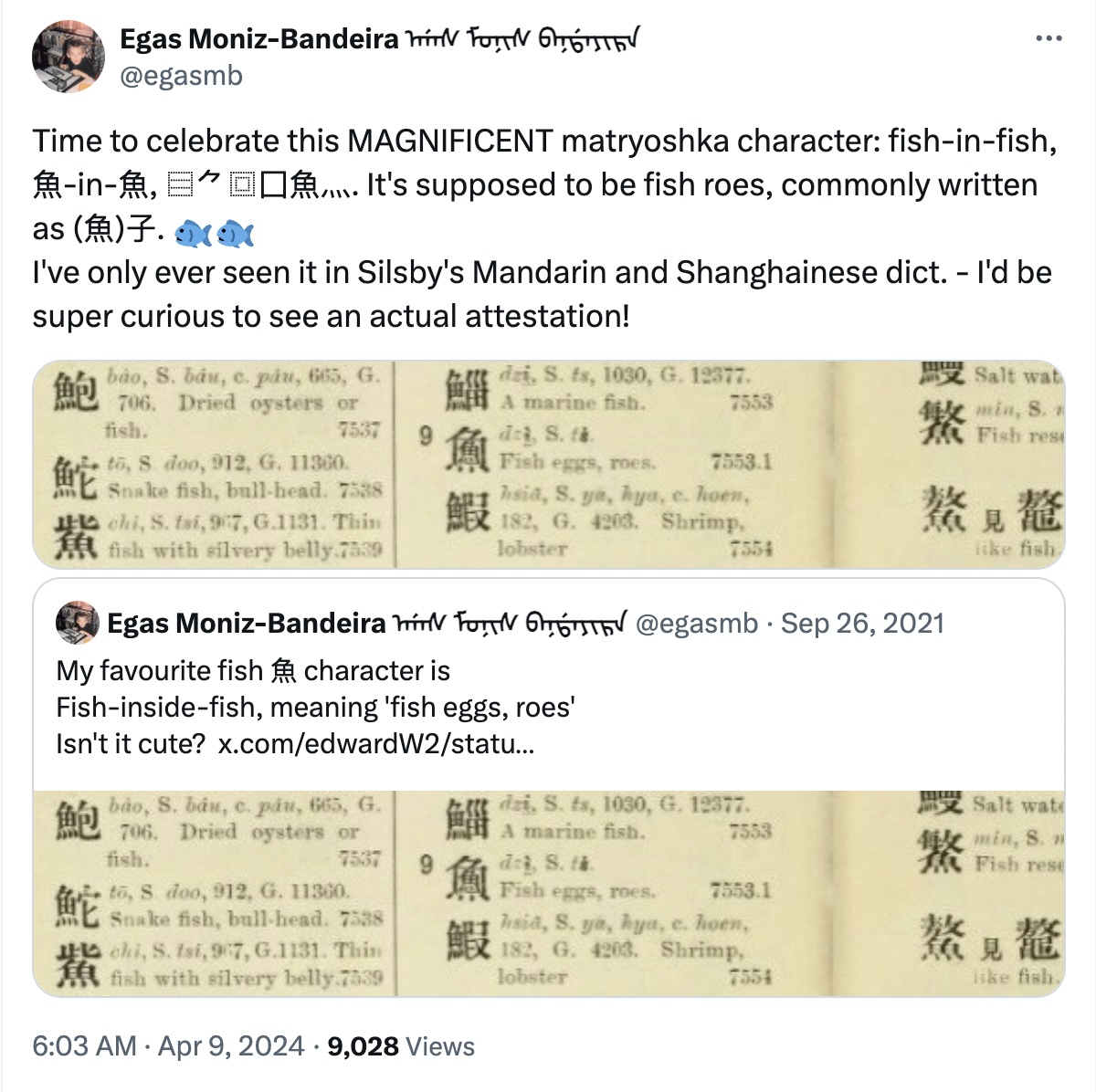Fish-in-fish matryoshka sinoglyph
« previous post | next post »
Egas Moniz-Bandeira on Twitter/X:
It's cute, clever, fun, but do the Chinese need it as part of their bloated (!) writing system?
Does Unicode need this inessential / nonessential / unessential sinoglyph as part of the world's functional writing systems?
Selected reading
- "Cucurbits and junk characters" (3/30/24)
- "Another "variant" character" (4/7/24)
- "Polysyllabic sinoglyphs" (4/11/24)
- "The economics of Chinese character usage" (9/2/11)
- "How many more Chinese characters are needed?" (10/25/16)
- "The infinitude of Chinese characters" (10/9/20) — with an extremely lengthy bibliography
[h.t. Geoff Wade]

Nat said,
April 14, 2024 @ 3:10 am
When I teach my students about composition of functions, I like to use the analogy of aphids, which are born pregnant (accounting for their extremely rapid pace of infestation). I don't think this helps my students' comprehension, but it keeps me amused, which is the important thing.
~flow said,
April 14, 2024 @ 3:24 pm
> Does Unicode need this inessential / nonessential / unessential sinoglyph as part of the world's functional writing systems?
Yes, because Unicode is essentially a registry of all the entities of all writing systems of all mankind, therefore, if this glyph was ever used, it belongs into Unicode. If 'used' should include 'appears only once in a dictionary' is of course a matter of debate; however, 'used' already does include 'appears only once in an *eminent* dictionary'.
One could argue that the entities of the Chinese writing system are really the components of characters, not the characters themselves; that was not done for two reasons: it does go against the conceptualization of probably a large majority of native and non-native users; it would be more difficult to implement (and would have posed even more problems when Unicode was first conceived around 1990). Roundtrip-compatibility with existing encoding schemes was certainly another consideration.
Incidentally this leads to another question: Has dynamic character composition from structural formulas (like the one in the post) been satisfactorily solved? It had not been when I last looked a decade or two ago. Because that would be the minimum must-have feature if one wanted to argue "we don't need more codepoints, just use the Ideographic Description Sequence".
John Chew said,
April 14, 2024 @ 3:45 pm
Unicode is not a universal writing system registry; it is a haphazard collection of whatever glyphs the consortium agrees to include. My own pet peeve is that they recognize that ABC and abc are different, but refuse to distinguish between titling and text figures. (Titling figures are the 0123456789 that you probably see here, where the tops and bottoms line up similarly to ABCDE…; text figures are the ones that are designed work better in mixed-case text, where the 4 descends below the baseline and the 6 ascends above the x-height.)
Chris Button said,
April 14, 2024 @ 11:15 pm
But it is a great character nonetheless!
Incidentally, one character unicode does seem to be missing is the right side of 暵. All it seems to have are the simplified form (with 艹 instead of 廿 on top) and the different form 堇.
Chas Belov said,
April 15, 2024 @ 12:26 am
I'll try to look it up in my Chinese dictionary. What's the Pinyin for dzi?
Chas Belov said,
April 15, 2024 @ 12:28 am
And trying to imagine the character for a jian bing filled with biang biang noodles.
Or a turducken, for that matter.
Chas Belov said,
April 15, 2024 @ 12:29 am
Or a turducken stuffed with biang biang noodles.